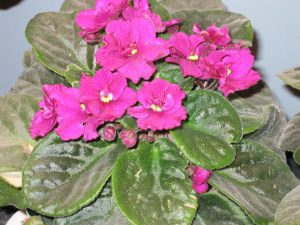
This is a fun time of year – sort of. Although cold and (normally) snowy outside, plant people are filled with joy and anticipation for the upcoming spring season. While ordering seeds can give us hope, we tend to like to get our hands dirty – literally. I find that this is a great time to propagate African violets. Yes, these plants can be somewhat challenging to keep long term; they are rather easy to propagate. I find that when propagating them, I tend to watch the adult plants more carefully and, therefore, they do better and last longer.
Keeping African violets is rather easy if you follow a few simple ‘rules’. First, their potting medium needs to be fast draining. They will rot if the soil remains soggy for too long. This is best accomplished by either buying a potting medium designed for them, or simply adding some extra perlite to a regular houseplant mix. I have found that filling the saucer under the pot with water is the best way to hydrate the plants. Any water remaining after an hour or two can be discarded. Care should be taken to avoid getting water onto the leaves as this cause diseases. This is another benefit of bottom watering as water is never being dumped on the leaves.
A regular, dilute (quarter strength) application of fertilizer with every watering works best for African violets, as opposed to periodic strong doses. These plants need bright light but will burn in direct sun. I have found them to thoroughly enjoy living under a table lamp. Although some specimens seem to hang on forever, to ensure a long-lived violet, they will generally need to be repotted once a year. This does not actually mean moving them to a larger pot, but just take them out of the pot and remove as much potting media as possible and replace it with fresh medium. Try and avoid too much damage to the roots, as this will hurt the plant. This freshens the rooting media by adding new nutrients, lessening media compaction and gets rid of any salts that may have accumulated on the media surface (a consequence of bottom watering).
If your house gets extremely dry during the winter, a pebble tray filled with water beneath the plant will help, as African violets like humidity. The air should move around the plant, as stagnant air leads to fungal infections that may result in death of the plant. Many people who collect African violets will use fans to move air across their growing tables in order to prevent fungal diseases.
Now that we have talked about how to keep violets, we can talk about how to propagate them.
Click here to continue reading.